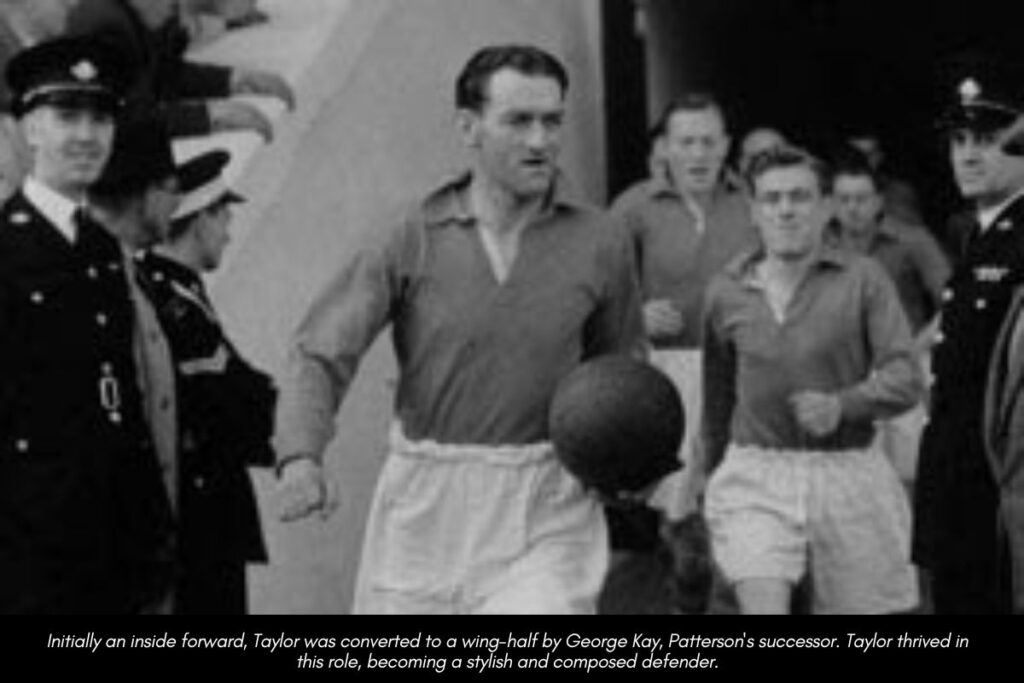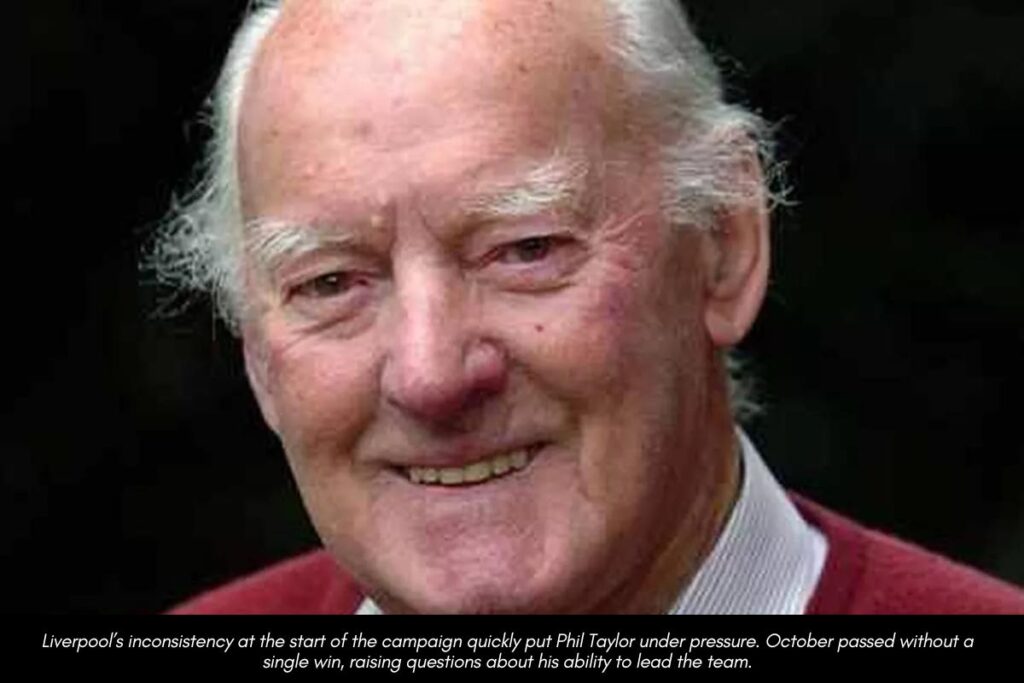Phil Taylor’s journey with Liverpool FC began as a promising player in 1936, continuing until 1954 before transitioning into management. Taking over from Don Welsh in 1956, Taylor faced the challenge of steadying a club reeling from relegation and struggling to find its footing. Though the 1950s were a tough decade for Liverpool, Taylor’s leadership kept the Reds in the top section of the table, showcasing his resilience and commitment to the club. His tenure laid crucial groundwork for his successor, Bill Shankly, who would transform Liverpool into a football powerhouse. Join us as we explore Phil Taylor’s impactful career and lasting legacy at Anfield.
The Early Life and Career
Phil Taylor was born in Bristol on September 18, 1917. He joined his local side, as a schoolboy and eventually became an apprentice, playing 21 league matches and scoring two goals. His performance as an inside forward caught the eye of then-Liverpool manager George Patterson. In March 1936, Liverpool signed Taylor for £5,000, with Ted Hartill going in the other direction. He made his debut later that month, scoring a late equalizer in a 2-2 draw against Derby County at the Baseball Ground.

Initially an inside forward, Taylor was converted to a wing-half by George Kay, Patterson’s successor. Taylor thrived in this role, becoming a stylish and composed defender. He played a crucial role in Liverpool’s post-World War II title win, making 35 appearances and scoring one goal. This success earned him an England call-up, debuting against Wales in a British Home Championship match on October 18, 1947, alongside legends like Tom Finney and Tommy Lawton.
Appointed Liverpool Manager
During the 1949-1950 season, Phil Taylor was appointed captain of Liverpool, leading the team to the FA Cup final at Wembley. Although Liverpool lost 2-0 to Arsenal, Taylor’s leadership qualities were evident. He ended his playing career at Anfield with 345 appearances and 34 goals, demonstrating versatility and talent. Taylor’s athletic prowess extended beyond football; he was also a first-class cricketer, playing for Gloucestershire in 1938. In 1954, Phil Taylor retired from playing but remained with Liverpool, joining Don Welsh’s backroom staff. Taylor’s experience and deep connection to the club made him a natural fit for a coaching role. His dedication and understanding of Liverpool’s ethos positioned him as a potential successor to Welsh.
By 1956, Liverpool was languishing in the Second Division, and Welsh’s inability to secure promotion led to his departure. Taylor, seen as a stabilizing force, was appointed as Liverpool’s manager. His appointment marked a new chapter for the club, aiming to return to the top-flight. Taylor’s familiarity with the team’s strengths and weaknesses, combined with his strategic insights, provided hope for Liverpool’s revival. His promotion to manager was a testament to his commitment to the club and his potential to lead them back to glory.
Unsuccessful Governance
When Phil Taylor took over as Liverpool manager, his primary goal was to return the club to the First Division. He prioritized the signings of Alan A’Court, Tommy Younger, and Ronnie Moran, with Moran later earning the nickname ‘Mr. Liverpool’ for his long-term contribution to the club’s coaching staff. Despite these strategic acquisitions, Taylor’s managerial tenure was not successful.
Liverpool finished third in Don Welsh’s final season, and it was hoped that Taylor could push them further. However, despite Billy Liddell’s goal-scoring prowess, the Reds finished third again, missing promotion by a single point and suffering an early FA Cup exit. The following season saw a slight improvement in the FA Cup, reaching the sixth round, but they finished fourth in the league. Phil Taylor’s efforts fell short, and his tenure was marked by frustration and unfulfilled potential.
An End to Management & a Game-Changing Replacement
Phil Taylor had another opportunity to get Liverpool promoted during the 1958-1959 season, which was the club’s 67th in existence. Despite hopes that two consecutive strong finishes would lead to success, a third-round defeat to Worcester City in the FA Cup signaled trouble. Losing 2-1 to a Southern League team was humiliating, and Liverpool finished fourth in the league for the second year in a row. Many believed this should have marked the end of Taylor’s tenure, but he was retained for the following season.

However, Liverpool’s inconsistency at the start of the campaign quickly put Phil Taylor under pressure. October passed without a single win, raising questions about his ability to lead the team. A victory over Aston Villa in early November gave some hope, but it was short-lived as a 4-2 defeat to struggling Lincoln City led Taylor to resign. At the time, Liverpool was 11th in the league, and Taylor admitted, “The strain of trying to win promotion has proved too much.”
In his resignation statement, Taylor expressed his disappointment, saying, “No matter how great has been the disappointment of the Directors at our failure to win our way back to the First Division, it has not been greater than mine. I made it my goal. I set my heart on it and strove for it with all the energy I could muster.”
The club then appointed Bill Shankly as the new manager on December 1, 1959, with Bob Paisley serving as caretaker manager in the interim. Shankly’s arrival marked a turning point for Liverpool, as he led the team to third place that season and laid the groundwork for future successes, cementing his legacy as an all-time great.
Conclusion
Phil Taylor’s time at Liverpool was a challenging period marked by unfulfilled ambitions and the struggle to return to the top flight. Despite his efforts and some notable signings, Taylor couldn’t secure a promotion for the club. His resignation paved the way for the appointment of Bill Shankly, whose transformative leadership would eventually shape Liverpool into a footballing powerhouse. Taylor’s tenure may not have brought the success he desired, but his role in the club’s history is significant. His commitment and love for Liverpool were evident, and his contributions laid the groundwork for the monumental changes that followed. Taylor’s legacy, therefore, is a reminder that even in difficult times, the seeds of future success are often sown.
Read all other posts on Phil Taylor
Find the Latest News on Player Ratings | Transfers | Prematch | Postmatch
Stay tuned for more updates on Liverpool FC Times and Stories. Your thoughts are always welcome in the comments section. Thank you for your continued support!
YNWA (You’ll Never Walk Alone)!
The Liverpool FC Times Team
LiverpoolFCTimes.com
